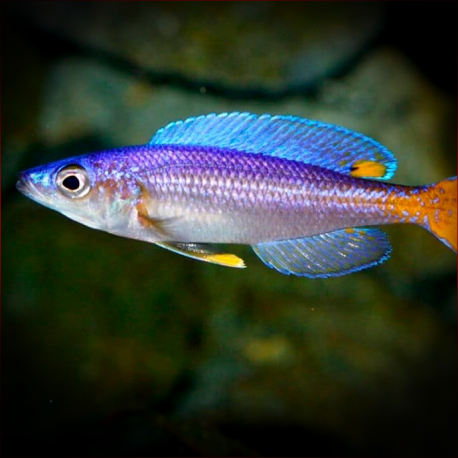More info
Datasheet
| Minimum Tank Size | 110 litres / 29.06 US gallons |
| Maximum Size | 12.5cm / 4.92inches |
| Temperature | 24°C / 75.20°F - 27°C / 80.60°F |
| Hardness | 10-25ºdH |
| pH | 7.8-9.0 |
General Description
The Sardine Cichlid (Cyprichromis Leptosoma) is a popular Tanganyikan cichlid species known for its peaceful nature and vibrant colors. It occurs in various geographical morphs, with blue and yellow-tailed forms. In the wild, they form large shoals and feed on zooplankton, displaying gregarious behavior. This species is ideal for Tanganyikan community tanks, offering peaceful cohabitation with other species.
Aquarium Setup
The Sardine Cichlid thrives in a tank with a capacity of at least 110 liters, preferring open swimming spaces in the upper levels. Tankmates should be carefully chosen to ensure compatibility, as this species is very peaceful. Suitable companions include other Tanganyikan species like Julidochromis or Altolamprologus. It is essential to provide sufficient space for a shoal of at least eight individuals, with recommended group sizes being even larger for optimal social dynamics.
Behaviour
Known for its peaceful demeanor, the Sardine Cichlid should not be housed with aggressive fish such as Mbuna. This species is highly social, showing fascinating behavior patterns in groups. In larger gatherings, it is common to observe the development of multiple alpha males displaying vibrant colors and establishing territories within the shoal.
Feeding and Diet
The Sardine Cichlid readily accepts a variety of foods, with live and frozen options making up the main components of its diet. Due to its small mouth and zooplankton feeding habits in the wild, it's crucial to monitor its feeding behavior closely, especially when first introduced to the tank. Ensuring the fish receives an adequate diet is essential for its health and well-being.
Reproduction & Dimorphism
This species exhibits sexual dimorphism, with males displaying much more vibrant colors than females. During reproduction, male Sardine Cichlids establish three-dimensional breeding territories in open water. Females carry fertilized eggs in their mouths for up to four weeks before releasing the fry. Breeders may opt to artificially strip the fry from the female's mouth for controlled rearing, although this method requires experience and careful handling.
Habitat and Distribution
Endemic to Lake Tanganyika, the Sardine Cichlid inhabits open waters in the intermediate zones with scattered rocks and sandy substrates. In aquarium settings, replicating this natural habitat with ample swimming space and rock structures is vital for their well-being. Maintaining water conditions within the specified ranges of pH 7.8-9.0, hardness of 10-25°dH, and temperature of 24-27°C supports the optimal health of this species.

